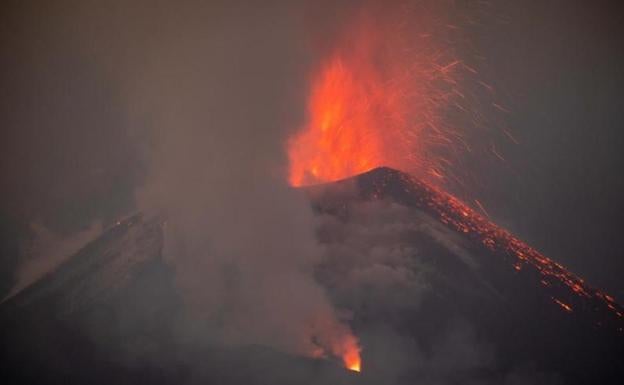
Sections
Highlight
Sections
Highlight

ANTONIO PANIAGUA
Friday, 19 November 2021, 12:24
Some two months after the start of the eruption of the Cumbre Vieja volcano on the Canary Island of La Palma, no one dares to predict its end, because as soon as it loses strength it regains it.
The molten lava spewing from the volcano has already claimed the life of one man - who was clearing ash from a roof when the property collapsed under the weight - and devastated homes, roads, farms and crops. Meanwhile, due to bureaucratic issues, little aid has yet reached the island residents and not one of those who have been left without a roof has yet taken possession of the homes acquired by the Canarian Government.
One day the volcano appears lethargic, the next day earthquakes shake the island. What will happen next? Sadly, there are no fortune-tellers in geology but, if trends are analysed, the volcano is showing perceptible signs of losing energy.
On Thursday, 18 November, the sulphur emissions ranged between 16,000 and 32,000 tonnes per day, a range much lower than the maximum 50,000 recorded on 23 September 23. But nothing can be guaranteed.
One unforeseen positive consequence of the eruptions is that La Palma's income will be increased as some 43 hectares of land has been reclaimed from the sea. “The island has grown in size, which requires a new map of the island to be drawn. And many budgetary issues are linked to the surface area of the island, which will have to be readjusted by the Canarian Government,” says José Luis Barrera, of the Illustrious Official College of Geologists.
"It is proving to be a long eruption," concedes Inés Galindo, a researcher at the Spain’s Geographical and Mining Institute (IGN). However, it is worrying to think that the Timanfaya eruption lasted six years, between 1730 and 1736, a precedent the technicians prefer not to think about.
When Spain’s Minister Reyes Maroto said that the volcano could become a tourist attraction, criticism rained down on her. But now it turns out that volcanic tourism is a reality. The tourist authorities initially said that it was better for the curious to refrain from visiting the island so as not to hinder the work of the emergency services. Now, even the commercial director of La Palma Tourism Board, Alfredo Capote, recognises that visitors eager to see the eruptions serve to reactivate La Palma's ailing economy.
Even so, this new market niche does not compensate for the losses caused by the desertion of Nordic and German visitors. Hotel occupancy levels are estimated at 45 per cent, when at this time last year, in the middle of the high season, 90 per cent of beds were occupied.
So far, little of the 214 million euros of national aid approved by Pedro Sánchez’s Government to rebuild La Palma have been seen while the president of the Canary Islands, Ángel Víctor Torres, said that the first estimates of the economic damage caused by the volcano range between 550 and 700 million euros, higher than 1% of the archipelago's GDP, which would allow the region to access EU funds for the reconstruction of the island.
Publicidad
Publicidad
Publicidad
Publicidad
Esta funcionalidad es exclusiva para registrados.
Reporta un error en esta noticia

Debido a un error no hemos podido dar de alta tu suscripción.
Por favor, ponte en contacto con Atención al Cliente.

¡Bienvenido a SURINENGLISH!

Tu suscripción con Google se ha realizado correctamente, pero ya tenías otra suscripción activa en SURINENGLISH.
Déjanos tus datos y nos pondremos en contacto contigo para analizar tu caso

¡Tu suscripción con Google se ha realizado correctamente!
La compra se ha asociado al siguiente email
Comentar es una ventaja exclusiva para registrados
¿Ya eres registrado?
Inicia sesiónNecesitas ser suscriptor para poder votar.